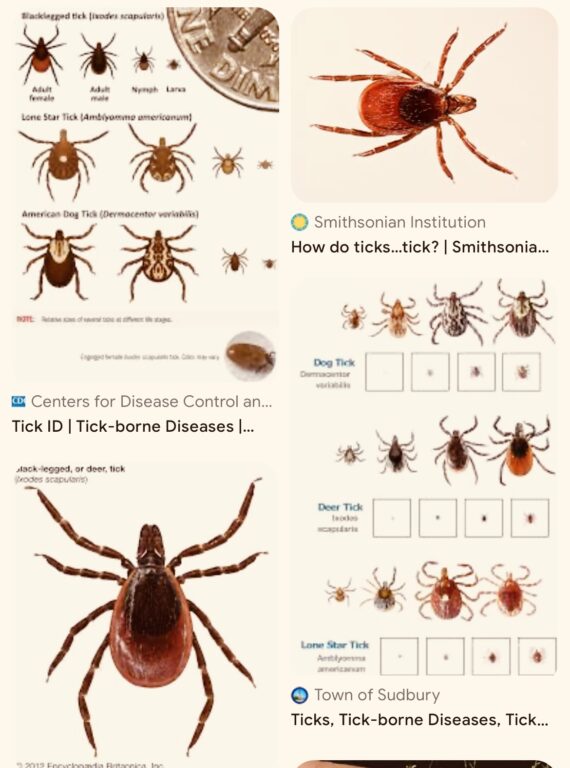Consumer Diary: Ticks

Audio By Carbonatix

I just put the Seresto flea and tick collar that our vet recommends on our dog Latke. It lasts around 8 months. We’ve been using them for several years. Photo credit: Harlan Levy
Consumer columnist and West Hartford resident Harlan Levy has more than 20 years of experience writing stories about everyday experiences that anyone could encounter.
By Harlan Levy
Hey consumers: With temperatures finally rising to the 50s, spring has definitely reappeared, and with it, has come a surge of ticks. The ticks threaten not only our always curious dog Latke but us, her human compatriots.
”They are very active right now,” Connecticut Agricultural Research Station insect expert Gale Ridge told me, “especially in sunny areas.”
Because of the relatively mild winter with long stretches of warmer than usual weather, everything was primed for an earlier than usual start here in New England, Ridge said. “If folks have known pests on their properties, it’s time to check for them now and not wait.”
So, consumers, here’s the situation …
Exposure can occur year-round, but April through September is when ticks are most active.

Courtesy of Harlan Levy
“I don’t know whether it’s going to be worse than last year,” Ridge said. “It depends on the weather. We’ve had a mild winter, so more ticks will have survived the winter. When it was 40 degrees or higher, we had more tick activity all winter, dominated by the black-legged tick, also known as the deer tick, in the West Hartford area and elsewhere in Connecticut. They’re all over Connecticut.”
- The deer tick bite can cause Lyme Disease. About 50% of deer ticks contain the disease-causing bacterium (and Babeosis, a parasite that infects red blood cells, causing anemia, which can lead to jaundice). Fever, chills, headache, fatigue, muscle and joint aches, and swollen lymph nodes (which may occur when there’s no rash) are symptoms. A rash occurs in 70 to 80% of infected persons and begins at the site of a tick bite after a delay of 3 to 30 days (average is about 7 days). It expands gradually over several days reaching up to 12 inches or more across and may feel warm to the touch but is rarely itchy or painful. Sometimes it clears as it enlarges, resulting in a target or “bull’s-eye” appearance and may appear on any area of the body.
- The Lone Star tick arrived in 2018-19 on an island off Norwalk and is found on the Fairfield County shoreline. In some people, it can cause a red meat allergy, an allergy to some sugars found in beef, lamb, and pork.
- The newest arrival here is the Gulf Coast tick, detected on the coasts of Connecticut and New York in 2020 and 2021. It looks very similar to the American dog tick, which is native to the central Connecticut region. The Gulf Coast tick’s markings have a silver sheen and the mouth parts are longer, while the dog tick’s markings are dull, and the mouth parts are short. The Gulf Coast tick carries a Spotted Fever bacterium, a form of which can be serious for dogs. People who are healthy will be OK if bitten, with a fever, headaches, and a general malaise, Ridge said. The bite initially results in a lesion generally within 2 to 10 days after the bite, followed in a few days by fever, a vesicular rash, headaches, and body aches. Patients generally recover completely following treatment with doxycycline. This disease is considerably milder than Rocky Mountain spotted fever without severe symptoms or deaths.
- The American dog tick carries Rocky Mountain Spotted Fever Disease, but it’s further south — in the Carolinas and Virginia. We don’t really see it up here, Ridge said. Symptoms include fever, chills, headaches, fatigue, muscle and joint aches, and swollen lymph nodes or rashes, according to the U.S. Centers for Disease Control and Prevention. If left untreated, long-term symptoms can include facial palsy, heart palpitations or irregular heartbeat, nerve pain and inflammation of the brain and spinal cord. Early signs and symptoms can appear three to 30 days after the bite.
What to do when you and your dog are walking outside:
- Wear long pants tucked in socks.
- Use EPA-registered repellents.
- Bathe, look, and feel for ticks after leaving tick habitats, and remove any ticks.
- Have ticks properly identified or tested at the Agricultural Station.
- Check pets for ticks, use tick control products; consult with your veterinarian about canine Lyme disease vaccine.
Every April we put a Seresto flea and tick collar on Latke’s neck, as our vet advised. Other products like FrontLine also defend pets against ticks.

The Seresta flea and tick collar I just placed on our dog Latke and have for several years, each one lasting about 8 months. Courtesy of Harlan Levy
Removing a tick
Use thin-tipped tweezers or forceps to grasp the tick as close to the skin surface as possible. Pull the tick straight upward with steady even pressure. Disinfect the area with rubbing alcohol, another skin disinfectant, or a topical antibiotic. Save the tick for identification or testing. If you suspect a tick-borne illness, consult your physician.
NOTE: If you have a consumer problem, contact me at [email protected] (“Consumer” in Subject line”), and, with the power of the press, maybe I can help.



